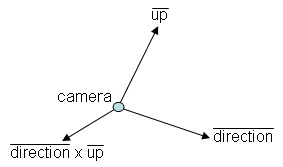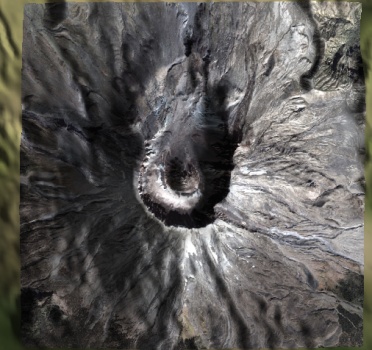Viewing
Default Camera Behavior
With no effort on your part, the 3D control automatically provides
rotating and zooming in a 3D scene using the mouse.
- Hold down the left mouse button and move the mouse to
rotate.
- Hold down the right mouse button and move to zoom in and
out. Zooming uses a logarithmic scale; as the camera approaches the
viewed object, the zooming speed slows down.
- Hold down the shift key and the left mouse button
and move to change the view direction without changing the camera
position.
- Hold down control and the left mouse button and
move to lock horizontal movement so you can rotate vertically
without accidentally changing your horizontal axis.
- Hold down alt and the left mouse button and move
to lock vertical movement.
Viewing Parameters
The
Camera, provides full control over the camera's position and
orientation. These are defined by three primary parameters:
- Camera Position - The position of the virtual camera in
the 3D scene.
- Direction - A unit length vector indicating the
direction that the camera is looking.
- Up Vector - A unit length vector indicating the
orientation of the camera. Informally, this can be thought of as
how the camera's head is tilted.

The camera's position can be retrieved using the camera's
Position property. The Position is returned in
PositionReferenceFrame. Similarly, the direction and up vectors
can be retrieved using
Direction and
UpVector, respectively. They are returned in the
Axes.
Viewing Central Bodies
ViewCentralBody is used to set the camera's position so that an
entire central body is visible. The view direction is set so that
the camera is looking toward the center of the central body.
ViewCentralBody is commonly used to restore a default view or view
different central bodies as shown below.
| [C#] |
 Copy Code Copy Code
|
scene.Camera.ViewCentralBody("Moon",
root.CentralBodies.Moon.Vgt.Axes["Inertial"]);
scene.Render();
|
|
The second parameter to ViewCentralBody defines the axes of
rotation. When the user holds down the left mouse button and moves,
this is the axes that the camera is rotated around.
Viewing Extents
ViewExtent zooms to a rectangular extent on the globe. In the
GraphicsHowTo,
this is used to set the camera such that an entire image overlay is visible.
| [C#] |
 Copy Code Copy Code
|
Array extent =
((IAgStkGraphicsGlobeOverlay)overlay).Extent;
scene.Camera.ViewExtent("Earth", ref extent);
scene.Render();
|
|
Azimuth is an angle from the positive x axis, in this case local
east, to rotate around z. Elevation is an angle to rotate from the
xy plane toward z.
In the rotation axes used by the camera after a ViewExtent, an
azimuth of 90 degrees is looking south, and an azimuth of 0 is
looking west. An elevation of 90 degrees is looking straight down,
and an elevation of 0 is looking toward the horizon.
General Viewing
View and
ViewDirection are used for general purpose viewing. They
provide direct control over the camera's position, direction, and
up vector - as opposed to
ViewCentralBody and
ViewExtent, which set these parameters implicitly.
VGT is used to create a view position and a reference point at
the point that the camera will look at; next, an axes of rotation
is created using east-north-up axes, similar to the axes created by
ViewExtent.
STK Programming Interface 11.0.1

 Copy Code
Copy Code